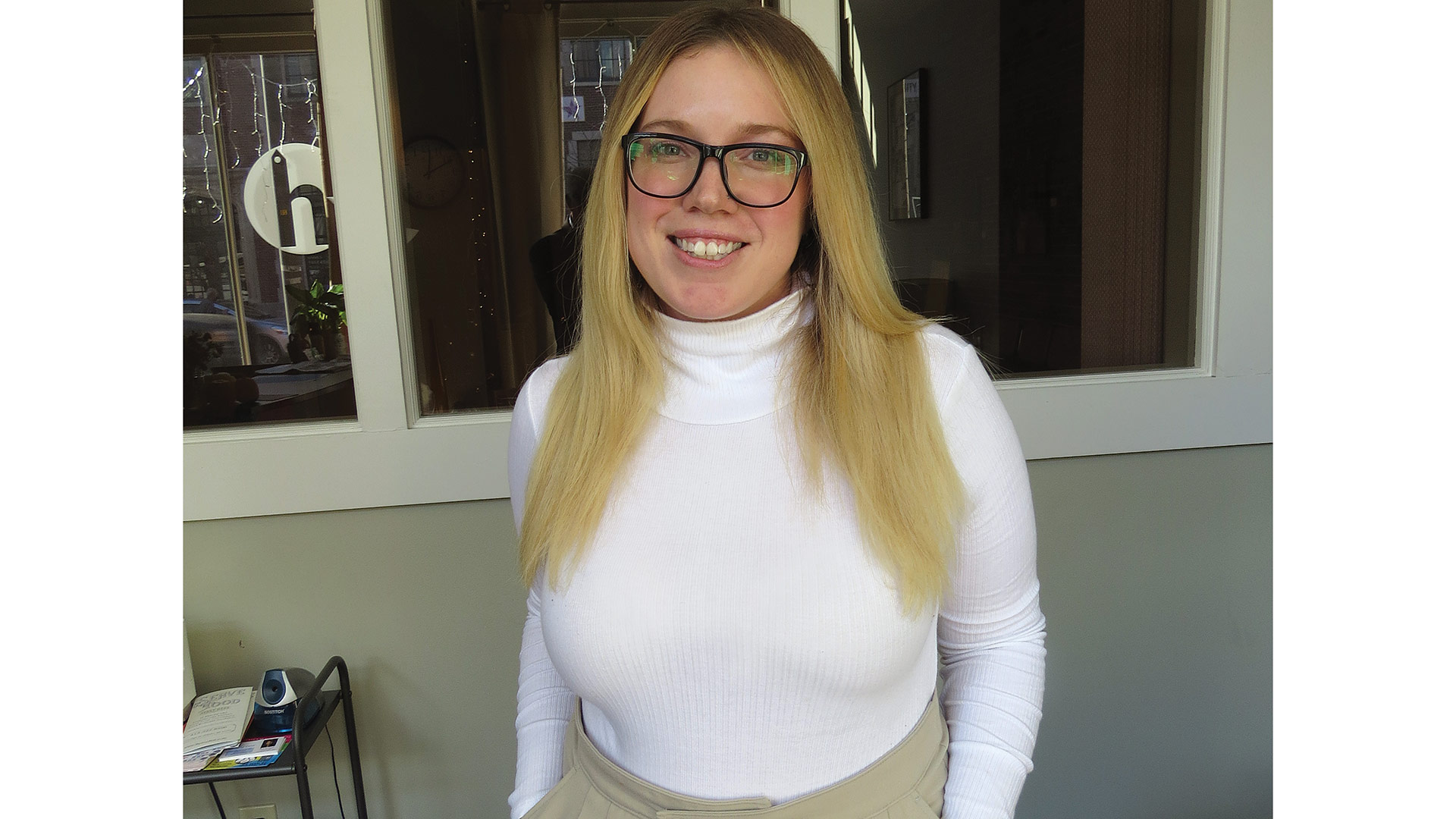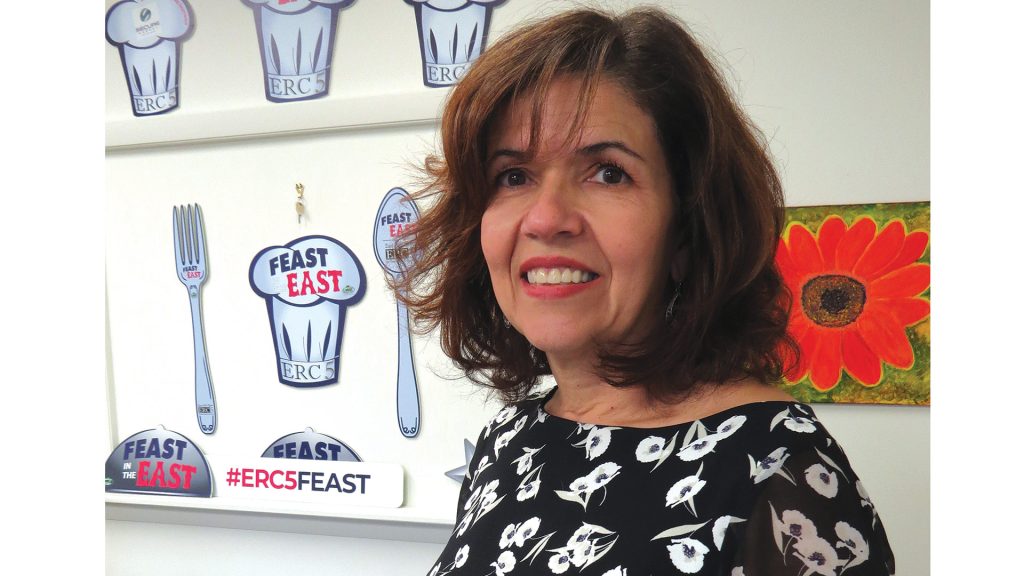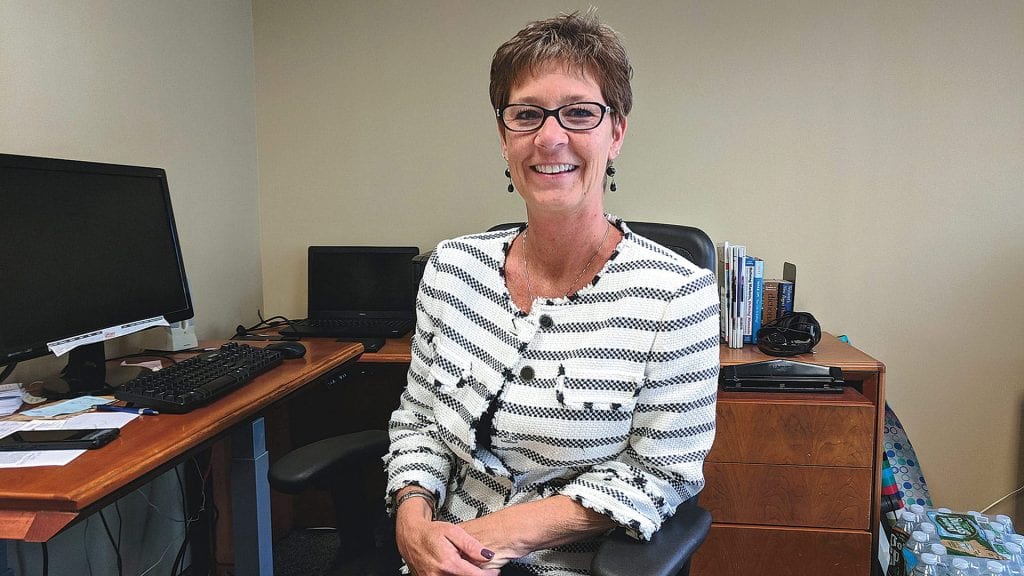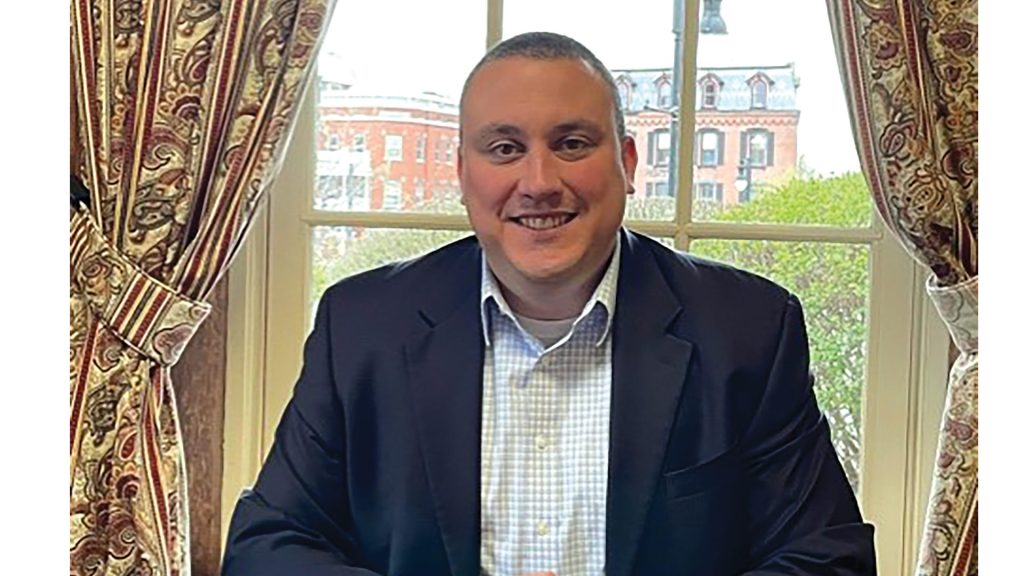Changing the Script

As part of a broad rebranding and rebuilding effort at the Greater Holyoke Chamber, Jordan Hart is working to build a stronger relationship with the Hispanic business community.
Area chambers of commerce, like businesses in all sectors, have suffered during the pandemic and faced a number of stern challenges. For the most part, they have come through these tough times — smaller in many cases, with many chambers now one-person shows — having proven their value and relevance after helping their members survive upheaval without precedence. The challenge moving forward is to rebuild their memberships, their financial foundations, and, yes, their staffs, while also creating new and different ways to maintain that relevance they found during the pandemic.
Jordan Hart admits to sometimes getting lonely at the Greater Holyoke Chamber of Commerce’s spacious offices on High Street.
There are still monthly board meetings in the large conference room and an occasional visitor. And the entrepreneur leasing a small office toward the back of the space comes in now and then.
But mostly, it’s just Hart.
Indeed, this chamber is now essentially a one-person operation, the culmination of a trend that started before the pandemic and has only been accelerated by COVID-19.
“I am the chamber,” said Hart, one several relatively new chamber leaders in the region — she became executive director almost a year ago after more than nine years with the agency in various roles, adding that there were five people working in the same space when she first started there.
And Holyoke’s is not the only area chamber to be run by a staff of one. That’s the model now in place at several agencies, including the Springfield Regional Chamber (SRC), which had five staff members just prior to COVID, but now there’s just one computer humming at its suite of offices at the TD Bank Building, a downsizing that happened over time.
“Part of it was attrition, part of its was budgetary as a result of COVID,” said Nancy Creed, president of the SRC, who announced earlier this month that she will be stepping down from her position no later than next spring to care for her elderly mother.
Coping with smaller staffs — and, in some cases, some loneliness — has been just one of the adjustments area chambers have had to make over the last few years, and especially since COVID. There have been some changes in the services they provide and how they are provided, and there has been somewhat of a change in role as well.
“As chambers stepped up, people saw us as a lifeline. We’re in the business of serving businesses, but never did we realize that we would actually be saving businesses.”
Indeed, where once chambers existed to help promote members and connect them to one another and the community, while also providing needed information on matters ranging from new legislation to changes in tax laws, the mission escalated during COVID — up to and including simply helping members survive an unprecedented disruption to their business and their life.
“As chambers stepped up, people saw us as a lifeline,” said Claudia Pazmany, executive director of the Amherst Area Chamber of Commerce. “We’re in the business of serving businesses, but never did we realize that we would actually be saving businesses.”
Overall, the chamber members we spoke with summarized what’s happened over the past 21 months or so by saying chambers became more relevant during the pandemic, as evidenced by the fact that membership didn’t decrease for many of them at a time of extreme financial duress for many of their members. In some cases, it actually increased.
“Throughout all of this, chambers have really shown their relevance,” Creed said. “It’s like having health insurance in some respects; you don’t ever want to use it, but you’re glad that it’s there when you need to use it, and we’ve shown what we can do and what our value proposition is.”
Now, the challenge is to remain relevant, they said with one voice, noting that they’re going about this assignment in many different ways.
At the Holyoke Chamber, for example, there has been a rebranding — a new logo and a new website, for starters — but also some strong outreach to Hispanic business owners, said Hart, adding that, historically, that population hasn’t felt as if the chamber represented them.
“It was really important to me to become a more inclusive organization, fostering not only our current members, but growing that and extending that into the Hispanic business community, which has really not had the same opportunities that the chamber has offered to other businesses,” she told BusinessWest, adding that she considers 2021 to be a comeback year for a beleaguered chamber. “I don’t want to continue to segregate the two different business communities, but instead find ways to become more unified and be the business community of Holyoke.”

Grace Barone says the East of the River Five Town Chamber has brought back many of its events, but with adjustments due to COVID.
At the East of the River Five Town Chamber of Commerce, which includes Longmeadow, East Longmeadow, Ludlow, and other communities south and east of Springfield, there has been a return to many of the gatherings staged before COVID, including the popular breakfasts, an important value-added service for members.
“There’s definitely a need for these kinds of networking events,” said Grace Barone, who came on as executive director of the chamber in June. “Everyone needed to know how folks were doing, how to adjust sales, and how to move forward in this world, so we set out to do that, to bring people together again.”
For this issue, BusinessWest talked with several chamber leaders about this process of ‘moving forward,’ and all that this phrase entails. As with businesses in every sector of the economy, it means pivoting when necessary and finding new and sometimes different ways to be relevant and present value to members.
Meeting Expectations
As she talked about her chamber’s recent trade show and fundraising event, the ERC5 Talkin’ Turkey Table Top 2021, Barone said she took a page from the playbook BusinessWest used at its 40 Under Forty gala in September — the one that called for spreading people out to help reduce risks during a surge in COVID.
“We utilized all the different spaces at Twin Hills Country Club that we could,” she explained. “We had some vendors outside and in the lobby — we provided people with more room. People had to do a little more traveling through Twin Hills, but it happened, and it was a success, and everyone was very happy.”
It was the same at an earlier networking event, staged outdoors in another nod to COVID, at the Apple Place in East Longmeadow, which boasts a creamery and a number of farm animals. It wasn’t your typical networking event setting, but it worked, serving as an example of thinking outside the box and making needed adjustments to how things are normally done, Barone said.
“Throughout all of this, chambers have really shown their relevance. It’s like having health insurance in some respects; you don’t ever want to use it, but you’re glad that it’s there when you need to use it, and we’ve shown what we can do and what our value proposition is.”
Making adjustments at events — and conducting fewer events overall — while also making due with smaller staffs, and often one person, are just some of the changes area chambers have been making since COVID changed the landscape.
“It has certainly not been easy, and chambers have to do more with less now,” Creed said. “But that’s not necessarily a bad thing — I think that’s just business, and everyone needs to learn how to do that.”
Overall, most chambers have handled the adjustments they’ve had to make. There have been cutbacks in staffing for many of the agencies — again, through attrition and some cuts — and other forms of downsizing. But while chambers have closed and merged in other parts of the country and even other parts of this state, all of the chambers in the 413 have kept their names and their identities.
That’s not to say there weren’t some precarious times. Indeed, when Kate Phelon, the long-time executive director of the Greater Westfield Chamber of Commerce, announced she would retire at the end of 2020, a search for a successor commenced that September. It was halted a few months later amid some concerns about the chamber’s future — and fiscal concerns stemming from the pandemic — but then started again as arrangements were made to collect past-due membership fees and take other steps to put the agency on solid financial footing.
“Dues started coming in, and people started getting creative about getting businesses into the chamber,” said Eric Oulette, who would eventually become that successor, adding that, today, membership is solid, at nearly 240 members, or roughly where things stood before the pandemic, with the ambitious goal of getting to 300 in the months to come.

Nancy Creed says area chambers certainly proved their relevance during COVID, and the challenge now is to maintain that relevance.
He’s confident the chamber can continue adding members and perhaps reach that lofty goal because of the value it has put on display during the pandemic, especially as a resource to members looking for needed information and guidance on relief programs.
Barone agreed. “We’ve been climbing higher and adding new members since I’ve come onboard,” she said, adding that the numbers have been steady and the chamber is on solid ground moving forward.
At the Holyoke Chamber, amid several changes in leadership, the agency fell out of view of many business owners and needed to not only rebrand but reintroduce itself to the business community and in some ways even reinvent itself. And Hart, because of her long tenure with the organization and familiarity with many of the business owners, thought she was in a position to orchestrate what could be called a turnaround.
“I thought I was in a position to really rebrand us and make it known that we’re here to help the community, because there was talk that the chamber was idle,” she told BusinessWest. “We were administering grants, but other than that, we had a very idle pandemic, so I took that opportunity last spring to rebrand us, with a new logo, new website, and new dues structure.”
The more significant aspect of what she is calling a ‘renaissance’ for this chamber is its efforts to promote inclusion and broaden the membership base by putting out a proverbial welcome mat to Hispanic business owners. It is doing this through a number of vehicles, including everything from diversity, equity, and inclusion seminars to complementary Spanish classes (Hart is taking one herself) and English classes as well.
“What I’ve noticed from working here almost a decade is that there are a lot of roadblocks preventing unification within our business community,” she said. “So if can we cross-pollinate and promote one another and highlight one another, using the power of the chamber to become an ally with everyone in our community, we can see tremendous growth. The potential is really endless, in my opinion.”
Getting Down to Business
As he talked with BusinessWest, Oulette was just returning from a ribbon-cutting ceremony, one of many he’s been part of over the past few months.
The giant scissors have been given a workout, he said, thanks in part to a surge in entrepreneurship fueled in some ways by the pandemic and the time it gave people to think about, and act on, their dreams of owning their own business.
“It was really important to me to become a more inclusive organization, fostering not only our current members, but growing that and extending that into the Hispanic business community, which has really not had the same opportunities that the chamber has offered to other businesses.”
“More than 20 businesses have opened up in the Greater Westfield area this year alone,” he said, adding that, from what he can gather, most area chambers are equally busy with those ribbon cuttings, and they represent just one of many ways chambers are showing up during these still-challenging times.
Indeed, with federal PPP money and other sources of funding, such as a large grant the Holyoke chamber has secured through its partnership with EforAll Holyoke, area chambers have been able to carry on — in somewhat different fashion, in some cases, and with a somewhat different mentality in others. And, yes, with fewer people at many agencies.
“We’ve transitioned to be more of a mission-driven organization than an events-driven organization,” said Creed, noting quickly that spending less time on events, such as those monthly or quarterly breakfasts that so many area chambers are known for, has freed up time for “things that truly matter.”
Using different words and phrases, all those we spoke with said essentially the same thing — although, for many, those events are still critical as ways to serve members and raise needed operating revenue.
But the pandemic has inspired all the chambers to look beyond those events and at different ways to help members, especially as they continue to battle not only the pandemic, but also a workforce crisis that is without precedent, and now new challenges to their existence, such as inflation and supply-chain woes.

Eric Oulette says he has been busy at ribbon cuttings, one of the many ways the Greater Westfield Chamber has been visible and involved.
While the pandemic has eased in some ways, said Pazmany, area chambers are still working to not only serve but save area businesses. And this work takes many forms, from supporting the Amherst BID’s proposal to build a new parking garage downtown to more global efforts to inspire people to buy local.
But the biggest issues, one that chambers are struggling to help with, are the supply-chain woes and the workforce crisis. And they have Pazmany worried because they are preventing businesses from fully bouncing back from the pandemic, and in some ways still threatening their existence.
“I’m worried that, though our business are performing and they’re still open … they’re often just hanging on because of staffing and because of supply-chain issues,” she said. “Look at restaurants; they can’t stay open and serve the same number of people they used to. Most restaurants are busy, but they have to close two days a week, and if a restaurant has to close two days a week, they’re not doing what they were doing before the pandemic.”
And because a chamber’s fortunes are tied to the relative health of the business community it serves, there is understandable cause for concern, she went on.
“I’m a chamber, I’m a member-driven organization, all my support comes from my members and dues and sponsorships,” she explained. “I certainly have a right to worry; we’ve certainly proven ourselves in terms of our value, but if you’re not making the money, you’re going to cut somewhere. And what we don’t know is how long this staffing shortage and these other issues are going to go on.”
“It has certainly not been easy, and chambers have to do more with less now. But that’s not necessarily a bad thing — I think that’s just business, and everyone needs to learn how to do that.”
Barone agreed, but noted that one of the enduring lessons from the pandemic is that challenges can be met if groups and individuals work together and think outside the box.
“If we learned anything from this, it’s that the community comes together; if it weren’t for the residents in our small towns, a lot of businesses, a lot of restaurants, would not have survived,” she said. “But the community rallied, and that’s the piece that we’ve got to take forward — not that we didn’t before, but we need to focus on that with chambers. If our businesses are doing well and they’re successful, they give back to the communities they’re in, and everyone thrives.”
Bottom Line
As she walked and talked with BusinessWest during a visit to the space on High Street, Hart pointed to the desk positioned in the front lobby, the one she occupied when she started with the agency a decade or so ago.
When she became executive director, she recalled, she sat at that desk for some time, partly because of the familiarity, but also, as a one-person show, she wanted to be out front, greeting whoever came through the front door.
She has since settled into her office located behind the conference room, her “zen space,” as she called it. The broad goal for 2022 is to rebuild the chamber’s finances and, hopefully, place another employee at that desk out front — or one of the other unoccupied workstations.
Getting Hart some company is just one of the many challenges to address, and hopefully overcome, as chambers — like the businesses they serve — move on from surviving the pandemic to life after it.
George O’Brien can be reached at [email protected]






